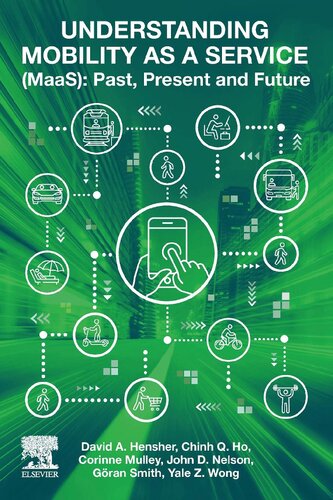(EBook PDF) Understanding Mobility as a Service MaaS Past Present and Future 1st Edition by David Hensher 0128203978 9780128203972 full chapters
$50.00 Original price was: $50.00.$25.00Current price is: $25.00.
Understanding Mobility as a Service (MaaS): Past, Present and Future 1st Edition by David A. Hensher – Ebook PDF Instant Download/DeliveryISBN: 0128203978, 9780128203972
Full download Understanding Mobility as a Service (MaaS): Past, Present and Future 1st Edition after payment.

Product details:
ISBN-10 : 0128203978
ISBN-13 : 9780128203972
Author: David A. Hensher
The widespread adoption of smartphones, ridesharing and carsharing have disrupted the transport sector. In cities around the world, new mobility services are both welcomed and challenged by regulators and incumbent operators. Mobility as a Service (MaaS), an ecosystem designed to deliver collaborative and connected mobility services in a society increasingly embracing a sharing culture, is at the center of this disruption.
Understanding Mobility as a Service (MaaS): Past, Present and Future 1st Table of contents:
Chapter 1: Overview
Abstract
1.1 Introduction
1.2 Themes to contemplate
1.3 Structure of the following chapters
Chapter 2: What is MaaS and how it fits into the transport landscape
Abstract
2.1 Introduction
2.2 Conceptualising MaaS: Bringing clarity to the proposition
2.3 Genesis for MaaS: Emerging transport disruptors
2.4 What could this mean for the transport landscape?
2.5 Modal efficiency and the rationale for integration
2.6 Improving modal efficiency through MaaS
2.7 Demographic change and the sharing culture: Niche or scalable?
2.8 Conclusions
Chapter 3: Global debate and experience with MaaS
Abstract
3.1 Introduction
3.2 Background to mobility as a service
3.3 What is meant now by mobility as a service?
3.4 Levels of integration and mobility as a service
3.5 Beyond the definition—Charting the development of mobility as a service
3.6 Reflections on the global debate
Chapter 4: MaaS trials—What have we learnt?
Abstract
4.1 Introduction
4.2 MaaS trials
4.3 Lessons learnt
4.4 Avenues for further experimentation and research
Chapter 5: What do we know about market interest and potential uptake?
Abstract
5.1 Introduction
5.2 Research on MaaS demand: Market surveys and real-world trials
5.3 Market interest
5.4 Willingness to pay and potential uptake
5.5 Conclusions
Chapter 6: How might MaaS be best introduced to the market?
Abstract
6.1 Introduction
6.2 How do governments procure transportation?
6.3 Establishing a MaaS broker/aggregator
6.4 A structured ecosystem for delivering MaaS
6.5 Business preference for a MaaS mobility model
6.6 Conclusions
Chapter 7: Institutional barriers and governance
Abstract
7.1 Introduction
7.2 Institutional framework
7.3 Institutional barriers to Mobility-as-a-Service
7.4 Implications for governance
7.5 Concluding remarks
Chapter 8: MaaS and issues impacting on broader transport and societal goals
Abstract
8.1 Introduction
8.2 Smart transition and societal impacts
8.3 Moving beyond the interest of MaaS providers and users
8.4 Some big questions currently without clear answers
8.5 MaaS and potential implications for levels of road congestion
8.6 MaaS and the future of conventional public transport
8.7 The multimodal conundrum for MaaS
8.8 Health
8.9 Greater government influence in MaaS provision
8.10 Government’s role in pricing and subsidy
8.11 Conclusions
Chapter 9: Future challenges
Abstract
9.1 Introduction
9.2 Revisiting the questions of the global debate
9.3 Unanswered and unasked questions: Framing the future research directions
9.4 Final words
People also search for Understanding Mobility as a Service (MaaS): Past, Present and Future 1st:
what is mobility as a service
mobility as a service examples
mobility as a service jobs
understanding mobility in america
mobility as a service definition
You may also like…
Politics & Philosophy
The Human Rights Covenants At 50: Their Past, Present, and Future 1st Edition
Technique - Transport
Business & Economics - Industries
Politics & Philosophy
Power-Sharing in Europe: Past Practice, Present Cases, and Future Directions 1st Edition
History - World History
Engineering - Civil & Structural Engineering
Politics & Philosophy - International Relations
Polarity in International Relations: Past, Present, Future 1st Edition Nina Græger
Technique - Transportation: Rail











